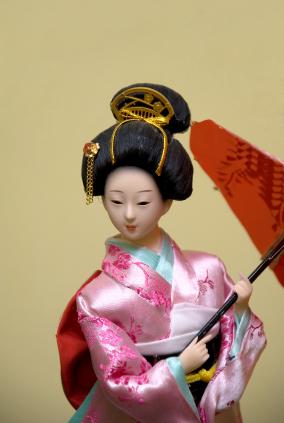
It's easy to become confused when trying to learn about Japanese parasol dance history. This particular dance form is misunderstood and confused with many imitations, but the real roots of the dance can be made clear.
Not a Geisha Dance
Contrary to what is written in Wikipedia, the Japanese parasol dance was not a featured dance of the Geishas. It wasn't supposed to be erotic or show off the dancers for their rich clientele. It also was not simply a dance performed with a Japanese prop, as has been written in many other places on the Internet.
A much better way to learn about Japanese parasol dance history would be to watch videos of the masters of the art perform it. For example, you can see Chibana Sensei performing with a parasol in a very chaste kimono in Virginia in 2008. The movements are graceful and precise, whether manipulating the parasol itself or even setting it precisely on the floor to counterpoint a dance segment.
This is the true kind of performance from the Okinawan dance tradition known as "Higasa Odori." Performed usually at spring festivals by one or many dancers, it has its roots in the traditional theater arts of Japan.
Japanese Parasol Dance History
According to the researchers who put together the Shurijo Castle Park New Year's Celebration in 2010, the Higasa Odori is a part of the classical Ryukyuan court dance technique that develooped in the 18th and 19th centuries. The principle function of these dances were to honor and entertain ambassadors from China. There were five different types of dances:
- Wakashu-odori: "young persons' dance"
- Rojin-odori: "old persons' dance"
- Uchikumi-odori: dramatic dance
- Nisei-odori: men's dance
- Onna-odori: women's dance
This type of dancing lasted until the prefecture of Okinawa was established, at which point it became part of the "outlaw" Kabuki theatre. Because the original Kabuki performances were deemed immoral and unfit for polite Japanese society, the theaters were built far outside the city walls, sometimes even in the river bottoms. Like many other forms of "outlaw" theatre, Kabuki became wildly popular, and its dance forms in the Ryukyuan style were handed down from performer to performer.
The Higasa Odori Is Created
Bridging the 19th to the 20th century was one of the final great masters of the Ryukyuan tradition of dance, a man named Tamagusuku Seiju. He created an "onna-odori" for a woman with an Okinawan style costume, from her hair to her delicate white tabi. It was a dance meant to evoke the summer season and the happy carefree feeling of a maiden playing in the fields. From its creation in 1934 (a little more than a decade before Tamagusuku Sensei's death) it became extremely popular, very much in demand and portrayed in many movies, plays, and festivals far beyond the classic Kabuki theatre.
There are two portions of the dance: the first, to a song called "Hanagasa-bushi", is a bright and colorful tune where the dancer moves about the floor. Then the second tune, the "Asatoya-bushi", gives the performer a chance to display grace and dexterity with her parasol (the "higasa").
The Modern and the Traditional Combined
While it may seem strange to qualify a dance that is almost a century old as "modern", the Higasa Odori does actually fall into that genre. Unlike many other Okinawan forms that have very precise movements, the parasol dance provides opportunities for the dancers and choreographers to add some personal expression to the dance while at the same time maintaining a connection to the very traditional art forms of their predecessors. In fact, in 2009, the Higasa Odori was the first dance performed by the senseis of Tamagusuku's school as a tribute to their founder. It is this combination of exuberant joy combined with the classic elegance and beauty of Japanese dance that has made the Higasa Odori one of the most popular dances performed both in Japan and abroad.







